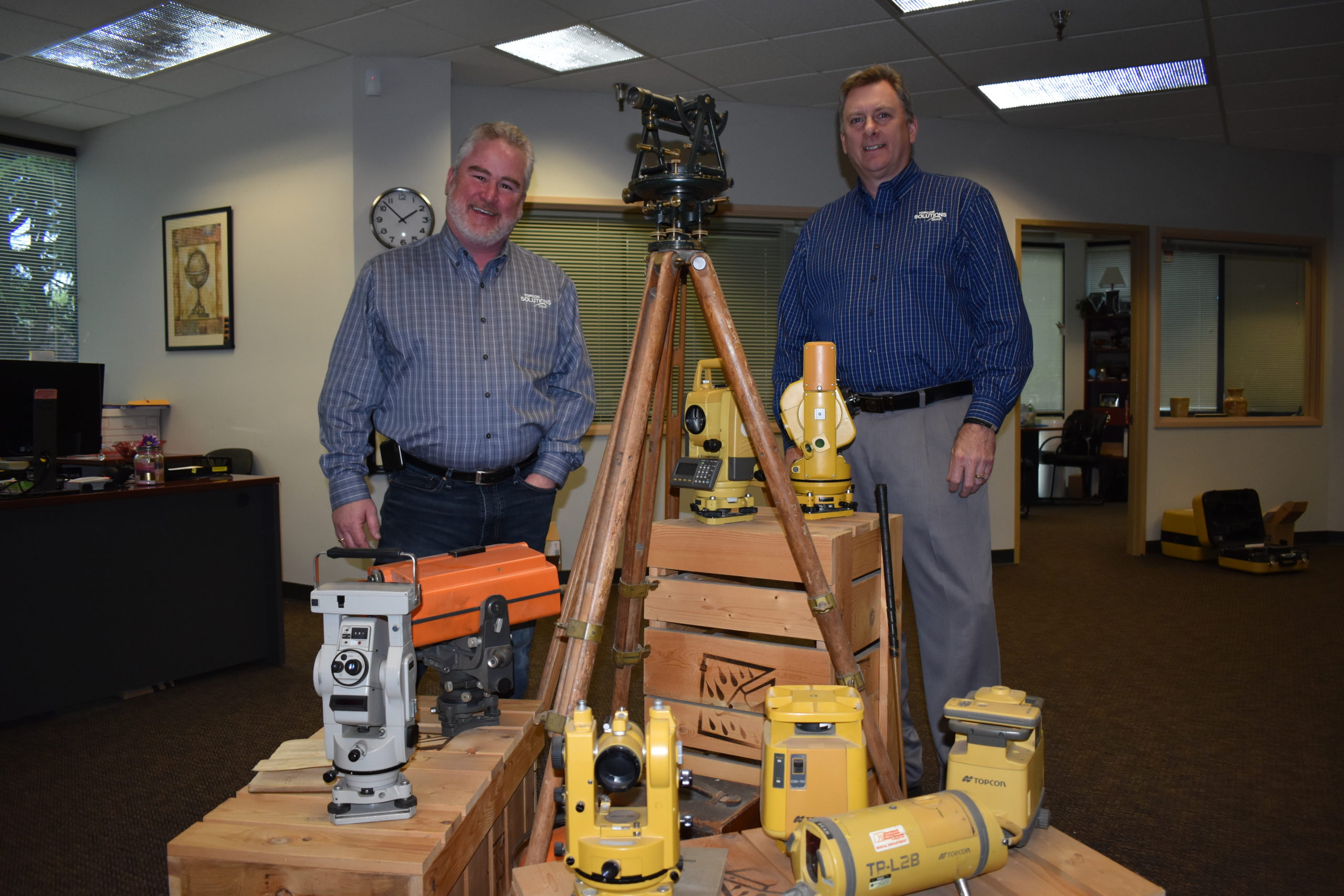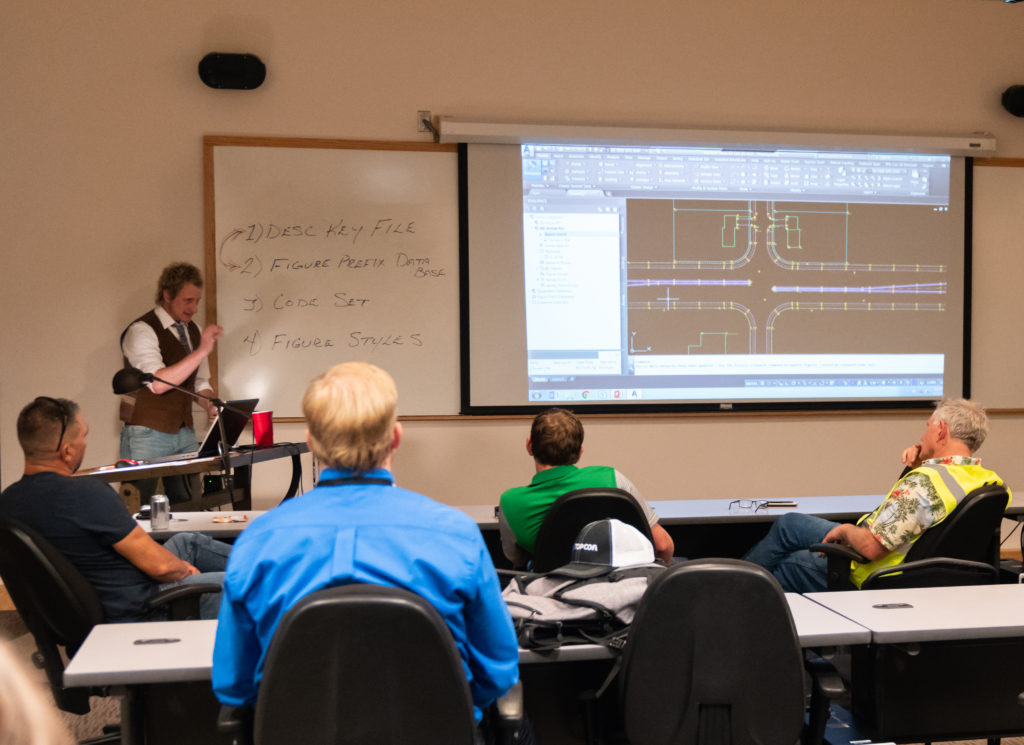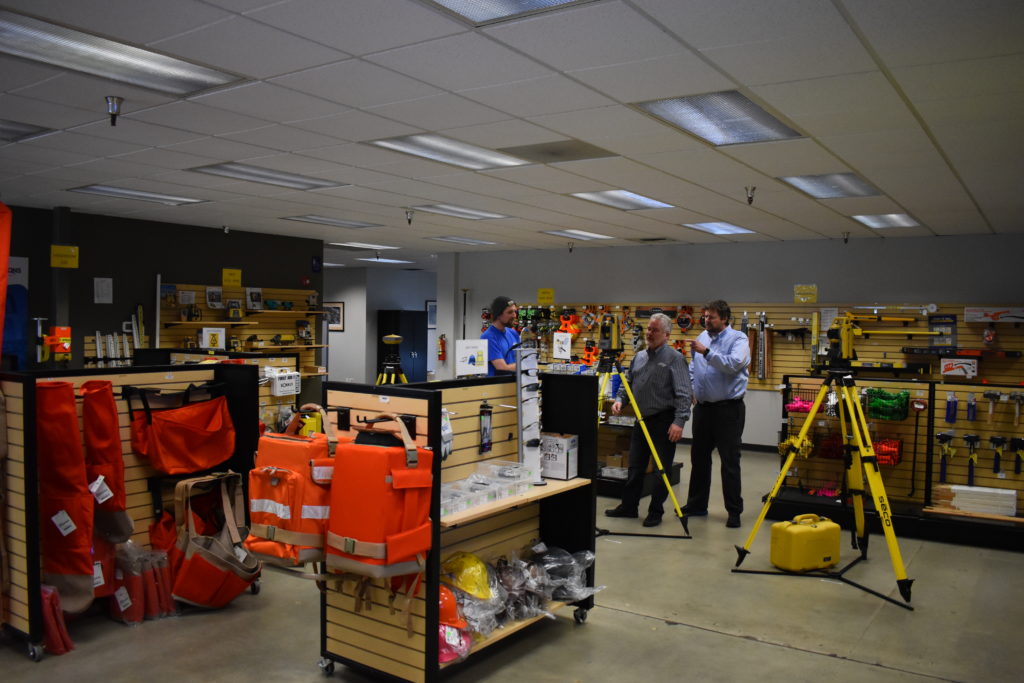Moves to modernize surveying, engineering, and construction were already well under way—recent events have simply accelerated the process.
Many, such as Topcon’s Solutions Store, have used the recent slowdown to adopt new models for workflows, collaboration, distributorships, training, and support to be ready to meet future demand.
As the pause button is being released, and a lot of stalled projects are back in play, prospects for surveying, construction, and infrastructure development look bright. Demand had been building for more than a decade. Now, not only is the already growing demand on a near horizon, but also there is a backlog from the pause.
AEC professionals and firms had already been on a modernization path, updating equipment, software, collaboration tools, getting folks trained and adopting new workflows. The industry that supports AEC has as well. Any modernization will put a premium on not only great tools, and folks trained to use them, but also consistent and strong support throughout the process and beyond.
A major change in the nature of distributorships, service, support, and training centers was long overdue, in many cases having not changed since the analog days. We recently visited one of the locations being hailed as a new kind of solutions center. We spoke to the team, customers, and a key industry partner.
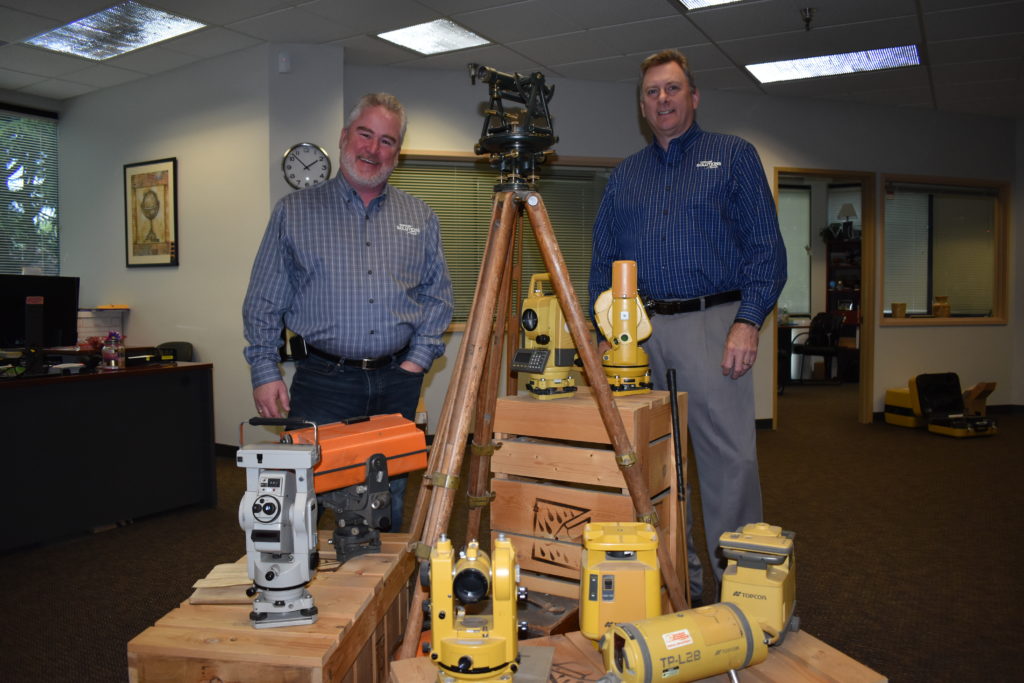
Mark Contino, vice president of North American retail distribution at Topcon Positioning Systems (left) and Ken Shersty, director of hardware sales for TSS, in a small museum of survey gear in The Solutions Store Kent, Washington, location.
A Reimagining
“I came from the field, my background is surveying in the Northeast before transitioning into surveying equipment retail which ultimately brought me out West,” Mark Contino said during a recent visit to Topcon Solutions Store in Kent, Washington. Contino is vice president of North American retail distribution at Topcon Positioning Systems. “A few years back, I was asked to look at the retail business and see what was going on. So, I spent two years visiting every location, talking to everyone, and to customers. My conclusion was that we needed a complete rethink of how we were doing things.
“We realized that we were running our retail business and locations like we were decades ago; like a small survey distributor—moving boxes,“ he said, referring to the traditional locally owned and operated dealerships. Such dealerships though were invaluable back in the day, as were the relationships built with the owners and operators. In the days of analog gear, a local dealership gave the personal touch and would often see multiple generations of surveyors as loyal customers.
But the nature of the work, the gear, the software, and the skillsets needed to meet client demands to plug into larger ecosystems has all changed. Many of the smaller dealerships are closed, and there have been consolidations, but often without reorganization. Something had to change.
“I also spent a lot of time at the main dealers and was surprised to see how many did not have a formal training room,” said Contino. “Maybe they had break room that they would cleanup when a customer came in to learn a new software. But there were a lot of other loose ends, like no service departments, and limited gear on display. I came back to Ray O’Connor [Topcon positioning president] and said that if we are going to be the ‘partner of the future’, as one of our slogans says, we need to ‘bring it’. We can’t just pretend or talk about it.”
So, a reimagined solutions center formed.
“When a surveyor, or construction person walks through the front door, I want them to see a showroom of everything they use, and see the service department, and for there to be great training rooms,” said Contino. “These are the three legs of the stool.”
“The service department so important. We work in a tough environment, rain, snow mud…got to keep the gear regularly serviced,” said Contino. We swapped tales of how long surveyors keep gear, for years, or even decades. The instruments become like a member of the crew. It is a little different, say, than project-based construction where gear might only be leased or purchased for the life of a project. “The total station or rover, they’re a surveyor’s baby,” Contino said. “[If] it’s down, you cannot work—that’s how important service is.”
“I asked customers what they were looking for, and the main things they told me were, ‘Where can I get training and support for the hardware and software, and who can take care of me?’ Not surprising, that has been a concern all along, but it got more acute,” said Contino. The lack of qualified workers, especially on the construction side, but also on the survey side. And the turnover…here we were with the economy humming along and I’d be told, ‘You just trained three of my people, and now they’ve left.’ Ok, we’ll train the next ones.”
“I talked to folks up in the customers C-suites [management]. They are less concerned with the robot and the nuts and bolts,” said Contino. “The hardware is pretty much a commodity, and to some degree so is the software, but companies are being asked to snap into larger ecosystems like BIM, and construction automation, so their main concerns are, ‘Is the work getting done? Is there a seamless flow between the field and the office?’”
The reimagining of Topcon’s channel market would need to fit the individual customer, but also small firms, large firms, their management, and fit into the brave new world of 4D digital design and construction.
Solutions Stores
The proposal was to purchase some dealerships, upgrade them and to launch as Topcon Solutions Stores (TSS) as a nationwide chain that would run, in many ways, independently of the parent company. Topcon did not spin off its construction side into separate dealerships. As Contino puts it, “We sell, support, service, and train for the entire portfolio from surveying, to mapping to construction.”
One of the goals was to maintain that local presence and the personal touch that go with it. There was an existing model in the two stores formerly known as Portland Precision Instruments (PPI) in Portland, Oregon, and Kent, Washington. Ken Shersty, now the director of hardware sales for TSS, managed both locations before the recent rebranding. He presented some background on how the locations evolved to the present model.
“PPI was founded over 90 years ago, as an industrial metrology company, and the company emerged as a major surveying equipment dealer by the 1970s,” said Shersty. “Tigue Howe, who joined in the 70s, had humble beginnings cleaning equipment but rose to lead the company. He had the vision to keep a strong focus on service and support roots, but to also added training.”
The strong service component of PPI features prominently at the TSS location I visited. In fact, the first thing customers see when entering the store is a large window looking into the service center. When I entered, I saw a total station on a stand being collimated.
Andrey Borishkevich is one of the service technicians at the Kent TSS. “I’ve been here, and at PPI before, since 2005,” said Borishkevich. “While in high school, I was cleaning cases, but started on-the-job training and got certified in servicing the equipment.” Certification training for construction lasers, pipe lasers and total stations is done at the Topcon Kansas City location, and for GNSS and some data collectors at the Livermore, California, location where many of those are built.
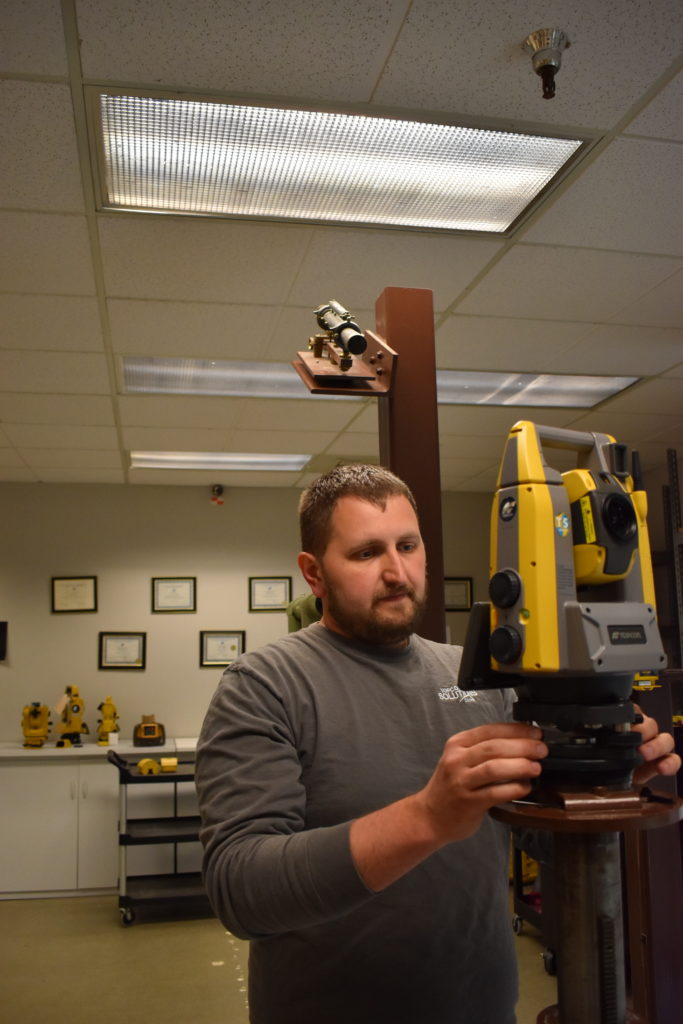
Andrey Borishkevich, also seen on this month’s cover, service technician at the Topcon Solutions Store in Kent, Washington, performs annual service on a robotic total station.
“There has been an uptick of people sending in equipment lately (during the current downturn); a good time to get equipment calibrated,” said Borishkevich. “We recommend yearly service for total stations. We check and replace seals; on older ones we might add some silicon as it is very wet up here [Pacific Northwest]. We collimate, and check lasers. We have targets in the room, at 300 feet and if we open the door there is one on [that distant building over there.]
“We will also load the newest software and firmware, and sometimes we have to recalibrate the tilt sensors when someone hits the wrong buttons,” said Borishkevich. “It usually only takes about six to seven hours for a full service for a total station, but sometimes longer if it has not been in for many years.” He adds “Please send them in yearly.”
Looking from the service center across a large showroom, there are several fully appointed training rooms. This location offers regularly scheduled training for Autodesk and Topcon products, and custom classes for customers ranging from a single user to groups of 20.
“When I joined over 20 years ago, we had already started offering some AutoCAD training,” said Shersty. “We were a Softdesk distributor and used to sell that as a package with total stations and offered a lot of training. So, when Autodesk bought out Softdesk, we were asked to become an Autodesk authorized reseller—now at the platinum level—and a certified Autodesk training center.”
But there is one element of PPI that Shersty is most proud of–the relationship with the local community. They regularly attend, sponsor, and help organize surveying association events, survey school job fairs, charity events, and education outreach. This is continuing under the TSS model and this local involvement will become a characteristic of all locations nationwide.
PPI had a brilliant model, half Topcon products and services and half Autodesk products and training. This mode was broadly recognized as a good model, and it was not uncommon for the Topcon factories and HQ in Japan to send applications and product engineers to the Kent location for some surveying and construction hands-on.
Now Contino just had to tweak the PPI model to emulate nationwide. This required investments in upgrading facilities. He noted that remodeling was not as expensive as first imagined, and for nominal costs they could upgrade leases or move locations, in some cases doubling floor space.
There was another factor in play that would work well with this new model–the roadshows. Topcon Positioning does not do a traditional giant user conference but does have a large presence at construction shows like Conexpo. Instead, they do series of roadshows in conjunction with local distributors. These are often held in open fields where everything in the portfolio is demonstrated, from survey rovers to heavy equipment.
“There are now 13 TSS locations across the U.S. and more in the works,” Contino said. “The real change comes when a Topcon Solutions Store works in cooperation with a local independent Topcon dealer that may cover only a portion of product line.” I asked how they will service and support other parts of the country in the interim, and Contino responded “With the web, virtual training, overnight shipping, and staff who are not hesitant to fly in to support and set folks up with new gear and software. We want layers of service combining TSS with independent Topcon dealers to provide best-in-class service in all 50 states.”
Coming Out Stronger
“We come out of every crisis learning something, from 9/11, 2008 (recession), the dotcom crash,” says Contino. “This is not like the 2008 crash. That was systemic; banking and housing market, underlying problems that took a decade to recover from. This one does not have systemic roots. It could be rough, but we should bounce back much faster.”
And it seems that in many places, heavy civil for transportation, utilities, and some types of development continued, business as usual. And with residential widely resuming construction, the analogy of a pause button is appropriate.
There is though, a lot of hurt: furloughs, projects parked, some cancelled and folks in AEC struggling to ride out the storm. But as Contino noted, a crisis or downturn gives folks pause to reevaluate how they do business, accomplish training, develop new process and business practices, and look at diversifying to help ride out subsequent downturns.
Early on in the crisis, Contino wrote an email to all of the 170 employees of TSS and asked what they could all do to help folks get ready for the recovery. They started the “Crisis to Recovery 2020” initiative. This includes good deals, stepping up virtual training, helping folks get used to remote operations and support, and various deferred payment options.
Their key partner in software and training, Autodesk, was offering similar assistance, and has a Covid-19 resource portal that also includes links to some of the TSS resources. But most of all, the focus for TSS was to accelerate implementation of the new nationwide model for sales, service, support, and training, and to be ready to meet the needs of the customers who are already beginning to rapidly gear up, train up, and be ready to catch the wave.
A Force Multiplier
A key element of the TSS model is the Autodesk connection. As a platinum reseller and certified trainer, TSS values Autodesk as a partner, and the feeling is mutual. We spoke to Theo Agelopoulos, senior director of infrastructure business strategy at Autodesk, for his take on AEC prepping for the future and the role of TSS in its business strategy.
“We’ve seen a pretty significant spike in customers using our cloud solutions to do collaboration in design and construction, stakeholder engagement, etc.” said Agelopoulos. “A big on-ramp of more customers connecting BIM workflows, and glad to have Topcon on the forefront of providing content and training to help our customers make that transition from primarily on-prem office to remote working the last several months.”
Elaborating on how the current situation fits into ongoing trends, Agelopoulos noted three areas of focus. First, there are customers who have already been moving towards digitalization of their operations–BIM, virtual design and construction (VDC), the cloud, etc.
“This has been kind of a force multiplier, rapid fire, sometimes out of necessity to keep projects moving while working remotely,” said Agelopoulos. “This might, for instance, see a firm that has been making 3D models in Revit, that was looking at moving into the cloud with BIM 360 in the future, suddenly deciding this is the time to do it. Having training resources like [TSS], who are closer to the ground truth of the customers really helps customers implement fast and provides the feedback we need to evolve our business and products.”
Second, how can Autodesk and TSS help customers work in whatever new normal there might be, for as long as it takes, and what if there are some permanent changes?
“Initially many customers may be looking at phased approaches to returns to on-prem and on-site operations,” said Agelopoulos. “Our solutions can help with micro-mobility simulations; looking at movement patterns and density of people in buildings and workplaces, like our customers do for airports and rail stations. We can also look at how to help customers deal with rework from parked projects, working in a mixed environment of remote collaboration and phased return to facilities.”
Third, what does it eventually look like when everyone must adapt? Besides just getting people back to the office, no one is sure if we are going to end up operating the same way in the future.
“Certainly, from a technology perspective we see an acceleration of using the cloud, using different processes, and hybrid work—beyond just using Zoom for meetings.”
How do you manage critical processes both in the office and the field, through design and construction?
“It will take a reskilling of the workforce,” said Agelopoulos. “Partners like Topcon, with their direct connection to the end users going though these changes, will be key to help us find that new normal long term.”
Digitalization Imperative?
I digressed a bit from the discussion about TSS to ask Agelopoulos his take about an ongoing question we have been exploring at xyHt for several years: Is digitalization of design and construction an imperative?
“We’ve been on the journey for the past 20 years, going from a CAD-based approach to design and construction to building information modeling. BIM is really a connected process, the tools that we build are there to enable more integrated processes,” said Agelopoulos.
“When BIM started it was literally buildings being built with it—‘building’ was a noun. But now, the same model-based processes BIM enables are not just used for vertical construction, now it is common for heavy civil, utilities, highways and more. It is more of a verb: You are ‘building’ an information model. And with that model you are not just conveying design to be built, with tools like BIM 360 you are managing construction—costs, scheduling, materials, etc.”
But why the push for more connected processes? He explained that we are seeing a consolidation and rationalization in the construction industry. Projects are getting bigger, more complex, we talk about the infrastructure gap, we talk about the number of buildings we need to build—multiple macro factors that have broad implications.
“We at Autodesk feel well positioned on the design side so we can bring best practices, but also about connecting design with construction,” said Agelopoulos. “And providing a connected experience. Customers are getting connected to minimize risk, optimize delivery, and this meets a lot of the constraints that are becoming more and more prevalent.”
For the past three to five years, Autodesk and others have been really looking to the cloud to truly complete the digitalization of AEC. The design side has essentially digitalized for over 20 years, with a major leap more recently in the transition from CAD to 3D models. Once working in models that are the foundation for BIM, the connection to construction is now practical.
“What took engineering decades to do in digitalization, construction can do in a matter of years,” said Agelopoulos. The difference is the cloud environment, AI, and machine learning that we have now. We can leapfrog past steps.”
It All Boils Down to Project Delivery
“We need to be able to serve our survey customers with the same personal touch and care [that] a solo operator, one– or two–crew shop came to rely on,” said Contino. “But the same for the small, mid and large contractor. That is why we are supporting Topcon’s entire portfolio, and Autodesk’s related products.”
I spoke with other staff at TSS, and they tell me that they are also growing their skillsets in order to diversify for the new types of customers. In the BIM space, the focus is different than the legacy days of just having really great hardware. New BIM customers are less concerned with the specifics of hardware (they can rely on their surveyors to make those choices) than they are on getting the building built, getting stuff done.
Of course the gear matters, but in terms of project delivery, you can have the greatest gear in the world and it does nothing if the crews are not trained to take advantage of it, or on how to use the integration and connectivity tools. How does it fit into the project ecosystem? Can we wait for folks to export this and import that like back in the day?
What Contino and his team at TSS are doing with the reimagined full service centers, and what Autodesk is seeking via the cloud, are tailored to unleash a whole new way to deliver projects, rapidly, accurately, coordinated, and, if necessity dictates, via a distributed environment. We can’t meet the demands of the huge wave of work that is resuming, with legacy tools and methods—modernize we must. The wave will not wait for us, we need to start paddling furiously if we intend to catch it.
Just in Time
“We would normally have been busier, as some projects got kicked down the road,” said Meredith Lambert, detailing manager with Conco, a commercial concrete contractor and key customer of both Topcon and Autodesk through the Solutions Store. “But we’re still busy and looking at how to get all of our projects done when things start back up.”
Conco is a whole package concrete contractor for large commercial construction. Their specialty is going vertical: small podium jobs like underground parking, at–grade retail, mid-rise buildings, but also 30– to 40-story buildings. They have grown to have teams in Washington, Oregon, California, Colorado and Nevada with projects throughout the West.
Lambert says they were long time Portland Precision Instruments customers (predecessor to TSS), now TSS customers for Autodesk products. In her role as detailing manger she oversees development of shop drawings and computer models of the concrete portion of projects that they share with the GC and MEP trades.
“What we call concrete outline drawings, and models are developed in Revit” says Lambert. “From these we do our CAD shop drawings, for rebar, formwork, and shoring.” Conco has the Autodesk AEC package, that includes Revit, AutoCAD, Civil 3D, InfraWorks, Navisworks, 3ds Max.
“This year we added BIM 360 cloud hosting and workshare models,” said Lambert. And timing could not have been better. “We got immensely lucky, we decided to get this storage model rolling in January. Who knew it would be so fortuitous in helping keep work rolling while sending everyone home.” The transition to this mode happened suddenly and it was badly needed—coordinating while distancing.
“There was very little disruption to our workflows. We may not work face to face, but we’ve been able to get through the nuts and bolts of modeling through BIM 360 now,” said Baxter.
While Conco had adopted Revit for modeling a dozen years ago, one of the drivers for transitioning to online collaboration with BIM 360 was that they work closely with their team in California. For instance, on a large project in Los Angeles where the models are the contract document, and measurements are taken directly form the models; three sets with eight models each for various disciplines. Prior attempts to work on collaborative platforms had left Lambert and her colleagues skeptical.
“We would often have to wait 20 to 30 minutes for models to sync. When we were given a demo of BIM 360 and saw that the models loaded in less than a minute, we needed no other convincing and moved forward.”
Lambert characterizes the service and support from TSS as impeccable, “They call me back right away even if their message says they are out,” she says.
Her team has attended both regularly scheduled classes at TSS (which is only a few blocks from their office in Kent), but also ad hoc training to help with the recent BIM 360 implementation.
The new environment also enables Conco’s field crews to be able to pull the model directly from the cloud. The transition was seamless. Lambert says that the biggest challenge when they had to suddenly work remotely was folks carving out office space in their homes and finding enough wireless cards and long LAN cables. Even after there is a return to offices, Conco is now fully prepared to work in the collaborative cloud environment on all projects moving forward.

